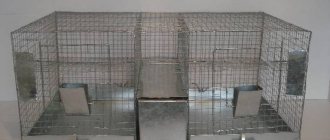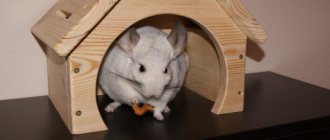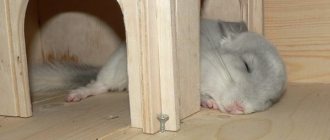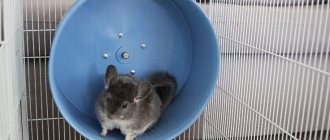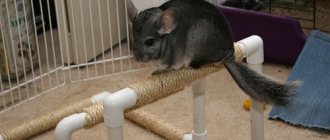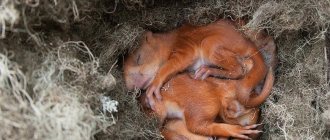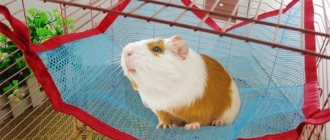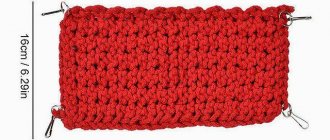Providing a chinchilla with good and proper nutrition is the most important task for its owner. If this is not done, the animal will often get sick, and you will spend a lot of time and money on its treatment. Therefore, it is better to immediately find out which food is best for your chinchilla. Nowadays there is a huge variety of food for chinchillas, so choosing is becoming increasingly difficult.
In this article we will look at what types of food there are for chinchillas and which one is best to choose, as well as a small rating of the most popular foods according to the owners of the animals. The food must contain all the necessary microelements and vitamins for the chinchilla to grow healthy.
Types of food for chinchillas
Two types of dry food are used for chinchillas:
- Regular, crumbly
- Granulated
Both are great for chinchillas, but there are significant differences. Regular food contains all the necessary vitamins and microelements, but the chinchilla will very often choose what she wants to eat. In this case, they can throw aside components that are unpleasant to her taste, which are actually very important for her health.
Granulated food, as you already understood, is granules in which all the components are compressed at once. The chinchilla will no longer be able to select individual components and will have to eat the whole food. In this case, she will definitely receive all the necessary vitamins and minerals.
As we have already understood, granulated food is slightly superior to regular food, but it is often more expensive. Therefore, you will have to decide for yourself what food to give your pet.
Feed classification
Based on the balance of composition and health benefits for rodents, all chinchilla food is divided into 2 large groups:
- Super premium class . This group includes food of the highest category, developed taking into account the slightest characteristics of the chinchilla’s body and made from high-quality raw materials. Eating such compounds will provide your pet not only with the proper functioning of its internal organs, but also with strong immunity and beautiful shiny fur.
- Premium class . The foods included in this group are slightly inferior in composition to super-premium formulations. However, they are considered a completely acceptable option for feeding your pet. The main thing is to choose a mixture that is suitable for each particular fluffy, and, as necessary, add vitamin and mineral complexes to the animal’s feeder.
It is worth noting that in rare cases, chinchillas completely refuse to eat super-premium food. In this situation, you should not force the fluffy one to eat the expensive composition; most likely, the animal simply did not like it. Therefore, you will have to switch to another mixture, perhaps of a lower class. There's nothing wrong with that.
Pros and cons of feed
Regular food
| pros | Minuses |
| Low price | Chinchilla doesn't eat it completely |
| Available in any store | Sometimes important microelements and vitamins are missing |
| You can do it yourself |
Granulated (compound feed)
| pros | Minuses |
| Eats all the food completely | High price |
| Contains vitamin supplements | Not available in all stores |
| Prevents intestinal diseases |
As you can see, each food has its own disadvantages, but the most important thing is that regular food is cheaper and you can make it yourself if you don’t trust stores. The composition of both foods is approximately the same, but the granulated food contains more useful additives.
What not to give to chinchillas
Chinchillas should not be fed food from their table, as well as various foods not intended for these animals. There is also a list of products prohibited for feeding exotic rodents.
What not to give to chinchillas:
- from grain crops - rye;
- juicy herbs, vegetables and fruits, because chinchillas may have indigestion;
- leaves of lily of the valley, buttercup, milkweed, field mustard, datura, marigold, fern, poisonous buttercup, larkspur and hemlock - these herbs are poisonous;
- branches - coniferous trees, chestnut, maple, cypress, white acacia, elderberry, plum, apricot, cherry;
- from fruits - citrus fruits, persimmons;
- vegetables – potatoes and fresh cabbage;
- pine nuts and almonds;
- apricot kernels;
- offal;
- meat, bones;
- any sweets (including dried fruits), honey;
- hard cheese;
- sausage and smoked meats;
- products of non-natural origin.
Composition of food for chinchillas
It is important to read the composition of the food to make sure that all the necessary components are present in it. And if some of them are missing, then it is necessary to change the food or give the missing vitamins in a different form.
Regular food usually includes:
- Barley, oats and other grains.
- Seeds
- Barley, corn or grass flour
- Bone meal, chalk and other calcium supplements
- Supplements with vitamins, lysine, etc.
The composition is quite simple and you can make this food yourself, read about it below.
Composition of granulated feed (compound feed)
Some call kibble food compound feed, but in reality it is just regular kibble food for chinchillas.
- Cereal products
- Meals
- Herbal flour
- Syrup
- Various oils, for example, vegetable
- Products with calcium, most often limestone
- Premix with vitamins and minerals
- Complex supplements containing all necessary vitamins and microelements
- Probiotics, phosphates, salts, etc.
- Supplements That Prevent Intestinal Diseases
Judging by the composition of granulated food, we see that it is much better balanced and will be an order of magnitude higher than regular food. And most importantly, it contains additives that prevent intestinal diseases, which are very dangerous for chinchillas.
Which food is better to choose
It is necessary to choose food for a chinchilla taking into account the individual characteristics of the rodent. To do this, you will need to carefully study the composition, and in some cases, get advice from a veterinarian. When choosing from the compositions listed above, you can use the following recommendations:
- Owners of baby chinchillas should pay attention to foods such as Padovan Grand Mix Сavie and Animals. Both products are suitable for furries of any age. The corresponding mark is on the packaging. If there is no marking, you must contact the seller for advice.
- For picky animals that are constantly sorting through food components, it is better to buy granular formulations - Madame Shinshi, Vitakraft, Beaphar Care. This way the pet is guaranteed to receive the required amount of nutrients.
- Fiory and Little One foods are ideal for pregnant females. They are rich in composition, contain vitamin supplements and are quite high in calories. All this is necessary to restore the strength of the expectant mother, because during pregnancy the load on the body increases several times.
- Beaphar Care, Fiory and Padovan Grand Mix Cavie are ideal for pets prone to colds. Because these foods contain additives that strengthen the immune system.
- To feed a chinchilla with malocclusion (or malocclusion), veterinarians recommend choosing soft, grain-free food. Benelux Grain Free chinchilla belongs to such compositions.
- If your pet suffers from gastrointestinal disorders, in particular from constipation, it is better to buy JR FARM or Vitakraft mixtures for feeding it. These foods contain additives that activate intestinal motility and promote regular bowel movements.
- Veterinarians recommend feeding chinchillas whose coats have lost their natural shine with food containing large amounts of vitamins and minerals. For example, Versele Laga or Beaphar Care.
- Budget. High-quality food does not have to be expensive. Therefore, thrifty furry owners can give preference to such compositions as Animals and Madame Shinshi. They belong to the budget segment food, but at the same time are able to provide the pet with balanced nutrition.
Before buying a pet, it will be useful for the future owner to read a brief overview of the most common chinchilla foods. This will help you carefully prepare for the arrival of a new family member and provide him not only with a new house, but also with tasty and healthy food.
Composition of premium food and how they differ.
To understand why you pay a lot of money when you buy premium food, you need to carefully read the composition. In this case, premium food from Fiory was used. Almost all premium food is supplied only in granules.
- The basis is taken from useful herbs: Timothy grass, medicinal dandelion, fescue, ryegrass, plantain, common gum, nettle leaves, thyme, shepherd's purse, two types of clover, meadowsweet, verbena, common fragrant spikelet, ragweed, plantain leaves, kupir, foxtail , Bermuda grass, peas, chicory, fennel.
- Quartz sand for grinding teeth
- Mineral supplements, yeast feed and yeast cell walls, chicory inulin, fructose, nucleotides, substances containing omega 3 and omega 6, beta glucan,
- As a result, we get the content of vitamins A, D3, E, B1, B2, B6, B9, B12 and several more.
- Balanced amount of fat, fiber and protein. 12% protein, only 3% fat, 43% fiber, 8% ash.
Unfortunately, this food states that it contains 0% calcium and phosphorus, which means you will have to independently add components that contain them to the diet. It turns out that premium food for chinchillas will not fully satisfy the need for useful components.
But the most important thing is that the composition is very diverse and contains many useful herbs, vitamins and microelements. The cost of such food starts from 400 rubles per pack, which weighs on average 800 grams. If a chinchilla eats 40 grams of food per day, then it turns out that 800 grams is enough for 20 calendar days, respectively, 1.5 packs of food are needed for months. This means you only need to spend 600 rubles per month for 1 chinchilla. I think this is not so much, but if you keep several chinchillas, the costs will be huge.
Reviews of ready-made food
Each breeder is guided only by personal experience and has his own opinion. Chinchillas are very picky eaters, and if one of them likes the food, this does not mean at all that the rest of the animals will eat it. Beafar food is recognized as one of the best. Its main drawback is the price. For 250 grams of food, on average you will have to pay 375 rubles. If the number of animals is large, it turns out to be quite expensive.
Many people find Little Van granules sweetish, so it is often mixed with crushed grain and used as a top dressing. However, most owners are satisfied with Green Valley feed. Even though it is more like compressed hay: it is clean, aromatic, varied, and rodents eat it willingly.
Vitacraft and Versele Laga also have many positive reviews and supporters. But about the Zverushka granules the reviews are the most opposite. Some owners complain that Zverushka pellets are unbalanced and have a high percentage of corn.
How to make food for chinchillas with your own hands
To begin with, I will write to you about the pros and cons of food that you make yourself for your chinchillas.
Pros.
- The food will definitely contain all the necessary vitamins and microelements.
- It will always be fresh, and you know exactly its composition
- If the chinchilla does not like certain components, they can be replaced with similar ones
- For each age, season and state of health of the animal, it needs to add different herbs and berries. Sometimes it is necessary to remove overly nutritious components from the diet if the chinchilla becomes obese.
- The food will be much cheaper, but in terms of beneficial properties it will be on par with elite food
There are not many disadvantages
- It is necessary to monitor the condition of the animal until it gets used to the new food.
- You need to buy different components yourself, which are not always easy to find.
What should be included in homemade food:
- It is imperative to have solid grain products so that the chinchilla has something to chew on.
- The base should consist of flour: grass, corn, wheat or barley
- A binding component, for example milk powder.
- There must be calcium, which is contained in lime, bone meal or chalk.
- Special additives. Food sulfur, leaves of nettle or berry trees.
- During cold periods or when the chinchilla is sick, it is necessary to add dry berries and herbs. For example, ground dry rosehip in small doses helps very well; it strengthens the overall immune system.
- Vitamin complexes with microelements, which are sold in any pet store. Their dosage is usually indicated on the package.
Feed preparation process
- Grind the necessary ingredients
- Mix all dry ingredients in any convenient container
- Add water by eye until all ingredients turn into a thick porridge.
- Pass through a meat grinder
- Dry in an electric dryer. You can dry it naturally, but only in very hot weather and low humidity. If mold or rot from moisture forms in the food, then in 99% of cases you will doom your pets to digestive problems.
The most popular pelleted foods
Chinchilla Complete by Versele-Laga
Packaging 500 grams – Average price: 400 rub.
Contains extruded granules that cover all the chinchilla's needs for fiber, vitamins and microelements. Contains many large fibers that allow teeth to be ground down while eating, preventing them from turning into hooks. The food contains many types of vegetables, seeds and herbs. When dried, they help chinchillas' digestion, which cannot function properly without a large amount of plant food. In addition to the main components, all the necessary vitamins, premix, minerals, prebiotics, all types of omega, several types of acids, as well as useful additives to strengthen the immune system are added to it.
Advantages:
- Low fat and carbohydrates
- Rich and balanced composition
- Low price
- Positive reviews on all Internet resources
Flaws:
- In small towns there are problems with the availability of this brand of food.
JR Farm Food Chinchilla Adult
Packaging 750 grams – Average price: 450 rub.
The food differs from others in its composition and contains a lot of dried fruits, vegetables and herbs. Thanks to the fruit content, the chinchilla will eat with great appetite, as it will be a delicacy for her. Also in the composition there is inulin, which is taken from parsnip root, it helps digest food and the proper functioning of the gastrointestinal tract. Yucca extract reduces the odor emanating from animal boluses. The required amount of fiber is provided by the presence of herbs: fennel, mint, thyme, etc. They not only help digestion, but also have a positive effect on other organs of the animal.
The food contains all the necessary microelements, so there will be no lack of calcium for bones or teeth.
Advantages:
- Rich and balanced composition
- Low price, especially if we consider the price per 1 kg
Flaws:
- Not so easy to find in pet stores, you have to order online
- Some components are suspicious
XtraVital Chinchilla Food by Beaphar
Packaging 1 kg – Average price 450 rubles.
The composition of the food is striking in its diversity. It contains not only herbs, but also many grains, fruits and vegetables. Its composition is highly enriched with minerals and useful additives to strengthen the immune system, so the animal should not have any health problems. The granules are quite large and hard, which allows the chinchilla to grind his teeth on them. A large amount of fiber supports proper digestion and prevents the development of gastrointestinal diseases. The food is recommended for middle-aged individuals when they need a lot of energy, of which this food contains a lot due to the high percentage of protein and carbohydrates.
Advantages:
- Enriched composition
- Lots of fiber
- Very low price
- Large packaging
Flaws:
- Too many carbs
- In addition to pellets, there are separate pieces that chinchillas eat first and can throw away the main food
Vitacraft granulated food.
Packaging 800 grams - Average price 800 rubles.
It is the leader among grain-free granulated food for chinchillas. Its composition is based on dried herbs rather than grain products. Due to this, it is easy to maintain a high percentage of fiber in the feed, which is very necessary to support digestion. It also included the popular ingredient inulin, which helps the entire gastrointestinal tract function properly. To enhance immunity, beta-glucan was added. They didn’t forget to include some vegetables, vitamin and mineral supplements. The granules are large and have a pleasant aroma, so chinchillas eat it completely.
Advantages:
- The food consists only of granules, there are no separate components
- No grain products
- Rich and balanced composition
Flaws:
- Few places available
- The packaging cannot be zipped or closed; this point needs to be thought out.
DIY food recipe, from one of the chinchilla owners
X: In my city it’s hard to find food; they only bring the cheapest food that is suitable for all rodents. I won’t say anything about its usefulness, because my chinchillas are very reluctant to eat it and have to throw away more than half of the portion.
They liked the granulated food most of all, and its composition was so varied that there was no doubt about its usefulness. There was one problem, it costs a lot of money. Even for 2 chinchillas I had to buy a decent amount; I can’t even imagine how expensive it would be to keep 4-5 chinchillas with such prices for granulated food.
After reading a bunch of literature and decided to make the food myself, but since I love my chinchillas and don’t want to risk them, I decided to show my food to several veterinarians and they advised me to remove some of the components. Along with this, I received some tips on what and when to add to chinchillas at different times of the year, and what not to add.
As a result, I ended up with this feed composition:
- Hay flour
- Medium-ground grains: oats, barley, wheat
- Wheat bran
- Ground corn
- Buckwheat
- Some flax seeds
- Peas
- Special feed shakes
- Hercules porridge
- Additive Premix P90-1
- Regular salt
- Tricalcium phosphate
- As a binding component, like everything else, I used milk powder.
The recipe is the simplest. I pre-grind the ingredients that require it in a regular coffee grinder. I leave the grains in such a form that the chinchilla has something to chew on, otherwise she will have nothing to wear off her teeth and hooks will appear. Then I just mix everything in a saucepan, add a minimum of water and put it through a meat grinder. Next, I dry it in an electric dryer and start checking it 2-3 hours after the start of drying. If you overdo it with water, it will take a very long time to dry.
I didn’t give them new food right away, I gradually got them used to it. In the first week he gave 25% of the new food, the next week 50% of the food. I constantly monitored how the chinchilla eats and saw that it eats store-bought and my granules absolutely equally, therefore, as soon as the store-bought food ran out, I immediately began to give a 100% portion of home-made food.
I wrote this recipe after 7-8 months of feeding my own food. I didn’t notice any changes in the chinchilla’s behavior. Those. no miracle happened and nothing bad either. She runs actively, boluses are of normal length, and has not yet encountered any digestive diseases.
This recipe is at your own discretion, so use caution when transitioning your chinchillas to it. If you notice any bad changes in your chinchilla’s condition, we recommend that you stop eating homemade food.
Nutrition for chinchillas in nature and in captivity
Chinchillas are herbivorous rodents. In nature, their diet is rather meager, consisting of cereals, various seeds, moss, bark and trees. In this case, each food component is dried with the help of wind and sun rays. In this regard, an important condition for keeping chinchillas at home is moderation in diet.
The basis of the menu for these animals at home is high-quality granulated feed, fresh hay and liquid.
In addition to these key components of the diet, the animal must also receive in the required quantities:
- Pumice.
- Mineral stone.
- Salt roller.
For chinchillas, it is of fundamental importance to use only granulated food created specifically for this type of rodent. Food intended for other animals is not suitable.
Experts recommend giving preference to granulated farm feed, which is produced directly for this type of animal. Factory-made food, especially inexpensive ones, usually includes preservatives, which guarantees the possibility of long-term storage, but makes it absolutely impossible to consume.
Therefore, when choosing factory feed, choose the one with the shortest shelf life. This granule does not contain preservatives in quantities dangerous for animals.
Typical mistakes when making food yourself:
- You cannot grind grains into fine flour. It is necessary to leave at least 1 ingredient in a hard form. If the chinchilla has nothing to chew on, then its teeth will not wear down and hooks will begin to form on its teeth.
- Do not add treats to the food. They must be given separately so that the chinchilla does not get used to them and does not develop intestinal problems.
- Do not use vegetables, fruits or fresh herbs. They will develop mold and rot, which will at least cause bloating in the chinchillas.
- Lack of beneficial additives and minerals. Some people think that natural food made from grains and cereals is enough for chinchillas, but this is far from the case. In nature, rodents themselves find the components they need, but in a cage this is impossible. Therefore, the availability of all the necessary vitamins and microelements rests on your shoulders.
- Instant transition to new food. The biggest mistake that leads to indigestion. Chinchillas need to be switched to a new food gradually, firstly, they have a hard time getting used to the new one, and secondly, it may not suit them. Start giving food in a ratio of 25% of the new food and 75% of their usual food, then observe the behavior of the chinchilla.
If your food contains all the necessary ingredients, then your pet will eat it with great pleasure. With proper nutrition, your chinchilla will live with you for more than 15 years.
List of healthy foods for chinchillas
When creating a menu for a pet rodent, you need to take into account the body's daily need for proteins, carbohydrates and fats.
Percentage of useful components:
- Proteins – up to 20%. This component is responsible for cell regeneration and fur elasticity. Lactating and pregnant rodents need to be given protein food in increased quantities, as it is responsible for the process of formation of the young's organs and milk production.
- Carbohydrates – up to 30-35% of the daily feed. They normalize the functioning of the digestive system and promote the removal of toxins from the body.
- Fats – 4-5%. They promote proper development, improve the condition of fur, and are an important source of energy for rodents.
The chinchilla's body also needs:
- magnesium – stimulating the body’s defense reactions;
- potassium – normalizes water-salt balance;
- folic acid – improves intestinal function;
- iron – promotes proper transport of oxygen to tissues.
An exotic pet's diet should contain healthy and high-quality products.
What to feed chinchillas:
- fresh hay;
- tree branches - pear, apple, sea buckthorn, birch, willow, etc.;
- dried herbs - parsley, spinach, burdock, plantain, clover, lettuce, dandelion grass, etc.;
- tree leaves;
- grain mixtures - wheat, corn, buckwheat, oatmeal, pearl barley;
- legumes - peas, beans, beans;
- pieces of dried vegetables - carrots, zucchini, tomatoes, bell peppers;
- dried fruits - apples, pears, grapes, bananas, apricots, figs;
- dried berries - blueberries, wild strawberries, strawberries, rose hips;
- nuts - walnuts, hazelnuts, peanuts.
The diet of pregnant and lactating chinchillas must include dairy products: milk, kefir, natural yogurt, cottage cheese, yogurt.
How to feed a chinchilla correctly
You need to feed your chinchilla granulated food in small quantities. On average, one adult animal eats 20 grams per day. If you see that the baby ate some pieces and left the rest, don’t worry. As mentioned above, chinchillas are very picky. First they choose the most delicious. But granulated food is a balanced diet, so the animal must eat everything. BUT! no need to force. Just leave the uneaten food until the feeder is empty.
If an animal throws away uneaten food, it means you need to reduce the diet, stop giving goodies and divide the daily food intake into 2 times. It is not uncommon to encounter particularly harmful animals that cannot be caught with all these tricks. A small diet will help - empty the feeder for several hours. In this case, the natural instinct will turn on: there is not always food, so you need to eat. Believe me, he will eat every crumb and will soon get used to the diet.
